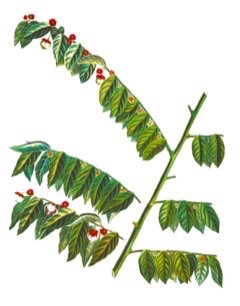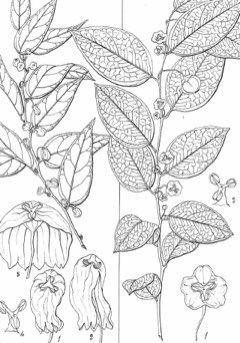 |
|
http://www.edibleplants.org |
 |
| http://www.edibleplants.org |
Translate this page:
Summary
Sauropus androgynus or also known as Sweet Leaf is a tropical shrub growing about 2-3m tall. It has small red flowers, compound dark green and oval leaves, and purple fruits. Mainly found throughout Southeast Asia, it is often cultivated as leaf vegetable. The leaves are used medicinally to treat coughs and fever but mainly used as food - either consumed raw or cooked. Young shoots and fruits are edible as well. The leaves yield green dye which can be used as food coloring. Plant can be propagated through leaf cuttings, stem cuttings, and seeds sowing.
Physical Characteristics

 Sauropus androgynus is an evergreen Shrub growing to 3 m (9ft) by 3 m (9ft) at a medium rate.
Sauropus androgynus is an evergreen Shrub growing to 3 m (9ft) by 3 m (9ft) at a medium rate.
See above for USDA hardiness. It is hardy to UK zone 10.
Suitable for: light (sandy), medium (loamy) and heavy (clay) soils, prefers well-drained soil and can grow in heavy clay and nutritionally poor soils. Suitable pH: mildly acid, neutral and basic (mildly alkaline) soils. It can grow in semi-shade (light woodland) or no shade. It prefers dry or moist soil.
UK Hardiness Map
US Hardiness Map
Synonyms
Clutia androgyna L. Sauropus albicans Blume
Plant Habitats
Edible Uses
Edible Parts: Fruit Leaves Shoots
Edible Uses: Colouring
Leaves - raw or cooked[296 , 418 ]. Young leaves make a good addition to salads, whilst older leaves are best cooked[296 ]. They can be added to soups or cooked with rice[46 ]. Young shoots about 7cm long, harvested as the leaves unfurl, have a flavour like asparagus[296 ]. A sweet flavour, rather similar to fresh garden peas[296 ]. The leaves are a good source of protein (about 6 - 10%[298 ]) and are very nutritious[296 ]. Ripe fruits can be made into sweetmeats[301 ]. A green dye, obtained from the leaves, is used for food dyeing[317 , 418 ].
References More on Edible Uses
Medicinal Uses
Plants For A Future can not take any responsibility for any adverse effects from the use of plants. Always seek advice from a professional before using a plant medicinally.
Antitussive Febrifuge Tonic
The leaves are used as a medicine for coughs and to soothe the lungs, as a tonic, and as a febrifugal to relieve internal fever[266 ].
References More on Medicinal Uses
The Bookshop: Edible Plant Books
Our Latest books on Perennial Plants For Food Forests and Permaculture Gardens in paperback or digital formats.

Edible Tropical Plants
Food Forest Plants for Hotter Conditions: 250+ Plants For Tropical Food Forests & Permaculture Gardens.
More

Edible Temperate Plants
Plants for Your Food Forest: 500 Plants for Temperate Food Forests & Permaculture Gardens.
More

More Books
PFAF have eight books available in paperback and digital formats. Browse the shop for more information.
Shop Now
Other Uses
Fencing Hedge
Agroforestry Uses: Plants can be grown as a hedge so long as they are trimmed regularly to keep them within bounds[298 ]. They are commonly grown as a living fence or to shade vegetable cultures[317 ].
Special Uses
Food Forest Hedge
References More on Other Uses
Cultivation details
A plant of the tropics, where it is well adapted to lowland conditions but can also be cultivated at elevations up to 4,000 metres. It grows best in areas where annual daytime temperatures are within the range 26 - 35°c, but can tolerate 5 - 38°c[418 ]. It prefers a mean annual rainfall in the range 900 - 1,200mm, but tolerates 600 - 4,000 mm[418 ]. Succeeds in full sun and semi shade[296 ]. Survives dry conditions and does not require a rich soil[296 ]. Tolerant of very heavy soils[298 ]. Tolerant of heavy rainfall areas, though they prefer a well-drained soil[298 ]. Prefers a pH in the range 6 - 7, tolerating 5.5 - 7.5[418 ]. First harvest may be taken after 55 - 70 days[418 ]. Plants can be harvested throughout the year[418 ]. In Java, the plant flowers all year-round and fruiting is usually abundant[418 ]. Plants are fairly resistant to insect predations[296 ].
References Carbon Farming Information and Carbon Sequestration Information
Temperature Converter
Type a value in the Celsius field to convert the value to Fahrenheit:
Fahrenheit:
The PFAF Bookshop
Plants For A Future have a number of books available in paperback and digital form. Book titles include Edible Plants, Edible Perennials, Edible Trees,Edible Shrubs, Woodland Gardening, and Temperate Food Forest Plants. Our new book is Food Forest Plants For Hotter Conditions (Tropical and Sub-Tropical).
Shop Now
Plant Propagation
Seed - borne in abundance on the plants, they germinate readily[298 ]. Cuttings - they strike readily[296 ]. Somewhat woody shoots, 20 - 30cm long are used[298 ].
Other Names
If available other names are mentioned here
Ngub, Pak-wan, Chekkurmensis, Chekup manis, Changkok manis, So-kun-mu, Kakul, Ruridama no ki, Cekur manis, Chekurmanis, Malunggay hapon, Phak waan, Rau nyot, Rau ngot, Sweet shoot, Kantong, Tarok manis, Chermela hutan, Babing, Katu, Katukan, Katuk, Simani, Pakwan, Thavasai murungai, Sengtungrung, Dieng-soh-pit, Bo ngot, Katuk, Phak waan baan, Pawing, Pamao, Midum-an, japan batu / mella dumkola
Native Range
TEMPERATE ASIA: China. TROPICAL ASIA: India, Sri Lanka, Papua New Guinea, Vietnam, Indonesia, Malaysia, Philippines,
Weed Potential
Right plant wrong place. We are currently updating this section.
Please note that a plant may be invasive in one area but may not in your area so it's worth checking.
Conservation Status
IUCN Red List of Threatened Plants Status : This taxon has not yet been assessed

Growth: S = slow M = medium F = fast. Soil: L = light (sandy) M = medium H = heavy (clay). pH: A = acid N = neutral B = basic (alkaline). Shade: F = full shade S = semi-shade N = no shade. Moisture: D = dry M = Moist We = wet Wa = water.
Now available:
Food Forest Plants for Mediterranean Conditions
350+ Perennial Plants For Mediterranean and Drier Food Forests and Permaculture Gardens.
[Paperback and eBook]
This is the third in Plants For A Future's series of plant guides for food forests tailored to
specific climate zones. Following volumes on temperate and tropical ecosystems, this book focuses
on species suited to Mediterranean conditions—regions with hot, dry summers and cool, wet winters,
often facing the added challenge of climate change.
Read More
Expert comment
Author
(L.) Merr.
Botanical References
Links / References
For a list of references used on this page please go here
A special thanks to Ken Fern for some of the information used on this page.
Readers comment
| Add a comment |
|
If you have important information about this plant that may help other users please add a comment or link below. Only comments or links that are felt to be directly relevant to a plant will be included. If you think a comment/link or information contained on this page is inaccurate or misleading we would welcome your feedback at [email protected]. If you have questions about a plant please use the Forum on this website as we do not have the resources to answer questions ourselves.
* Please note: the comments by website users are not necessarily those held by PFAF and may give misleading or inaccurate information.
To leave a comment please Register or login here All comments need to be approved so will not appear immediately.
|
Subject : Sauropus androgynus
|
|
|
|